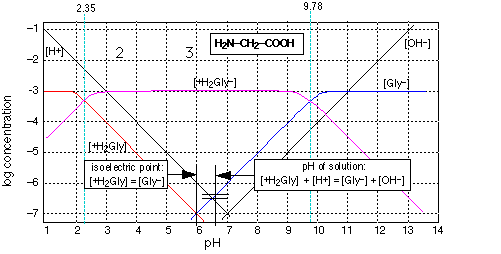

Glycine is the simplest of the amino acids, the building blocks of proteins. It is also a zwitterion (the word comes from the German term for "hermaphrodite" ) which chemists use to denote a species that possesses both an acidic and a basic functional group, both of which can simultaneously exist in their ionized (conjugate) forms. Examination of this graph shows that the double-ionic form (the true zwitterion) reigns supreme between pH 3 and 9; outside this range, the glycinium anion or the glycinate cation prevails. Notice that the completely un-ionized form does not exist in solution.
The log-C vs. pH diagram is constructed as s superposition of plots for each conjugate pair at its respective pKa. Note especially that the pH of a solution of glycine does lie exactly at the crossing point [Gly–] = [H+], but is slightly displaced from it according to the proton balance equation shown in the inset on the graph. The other important quantity shown on this graph is the isoelectric point, which is the pH at which the concentrations of the cationic and anionic forms are identical.
It goes without saying that treating this system algebraically would be far more complicated than the results would warrent for most applications.